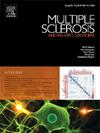NMOSD伴区域后发综合征患者首次发病的历程,单中心回顾性研究
IF 2.9
3区 医学
Q2 CLINICAL NEUROLOGY
引用次数: 0
摘要
视神经脊髓炎谱系障碍(NMOSD)的典型表现之一是区域后发综合征(APS),表现为恶心、呕吐或打嗝持续时间超过48小时。该综合征通常被误诊并伴有诊断延迟。本研究旨在了解APS作为初始发作是否与巴西人群首次神经内科就诊和诊断的时间较长有关。从患者记录和患者访谈中收集了74例患者的数据。最常见的首发表现是视神经炎29例(39%),孤立性APS是12例(16%)患者的首发临床症状。APS组到第一次医疗服务的中位时间为7天,非APS组为4.5天(p = 0.87)。APS组首次神经学评估的中位时间为232.5天,而非APS组为25天(p <;0.001)。APS组和非APS组的中位时间分别为344天和164天(p = 0.051)。12例APS患者在诊断前均有再次发作,诊断前发作次数中位数为3次(范围2 - 5),非APS组为2次(范围1-5)(p = 0.001)。非APS组有45例(72.5%)患者接受了急性治疗,而APS组无患者接受急性治疗(p = 0.001)。APS作为NMOSD的第一个表现与神经学评估的延迟、诊断前发作次数的增加和未经治疗的发作有关。本文章由计算机程序翻译,如有差异,请以英文原文为准。
The journey of the patient living with NMOSD with area postrema syndrome as the inaugural Attack, a single center retrospective study
One of the typical manifestations of Neuromyelitis optica spectrum disorder (NMOSD) is the Area Postrema syndrome (APS), defined by nausea, vomiting or hiccups lasting longer than 48 h. This syndrome is usually misdiagnosed and associated with diagnosis delay. This study aims to understand whether APS as the initial attack is associated with a longer time to first neurology visit and diagnosis in a Brazilian population. Data from 74 patients was collected from patient records and patient interviews. The most common first manifestation was optic neuritis 29 (39 %) and isolated APS was the first clinical syndrome in 12 patients (16 %). Median time to first medical care was 7 days in the APS group and 4.5 days in the non-APS group (p = 0.87). Median time for first neurological assessment was 232.5 days in the APS group while it was 25 days in the non-APS group (p < 0.001). The median time to first disease modifying drug was 344 days in the APS group and 164 days in the non-APS group (p = 0.051). All 12 APS patients had another attack before diagnosis with a median attack number before diagnosis of 3 (range 2–5) and 2 (range 1–5) in the non-APS group (p = 0.001). Acute treatment was performed in 45 (72.5 %) of non-APS group while no patients on the APS group had received acute treatment (p = 0.001). The APS as the first NMOSD manifestation was associated with delay to neurology assessment, higher number of attacks before diagnosis and untreated attacks.
求助全文
通过发布文献求助,成功后即可免费获取论文全文。
去求助
来源期刊

Multiple sclerosis and related disorders
CLINICAL NEUROLOGY-
CiteScore
5.80
自引率
20.00%
发文量
814
审稿时长
66 days
期刊介绍:
Multiple Sclerosis is an area of ever expanding research and escalating publications. Multiple Sclerosis and Related Disorders is a wide ranging international journal supported by key researchers from all neuroscience domains that focus on MS and associated disease of the central nervous system. The primary aim of this new journal is the rapid publication of high quality original research in the field. Important secondary aims will be timely updates and editorials on important scientific and clinical care advances, controversies in the field, and invited opinion articles from current thought leaders on topical issues. One section of the journal will focus on teaching, written to enhance the practice of community and academic neurologists involved in the care of MS patients. Summaries of key articles written for a lay audience will be provided as an on-line resource.
A team of four chief editors is supported by leading section editors who will commission and appraise original and review articles concerning: clinical neurology, neuroimaging, neuropathology, neuroepidemiology, therapeutics, genetics / transcriptomics, experimental models, neuroimmunology, biomarkers, neuropsychology, neurorehabilitation, measurement scales, teaching, neuroethics and lay communication.
 求助内容:
求助内容: 应助结果提醒方式:
应助结果提醒方式:


